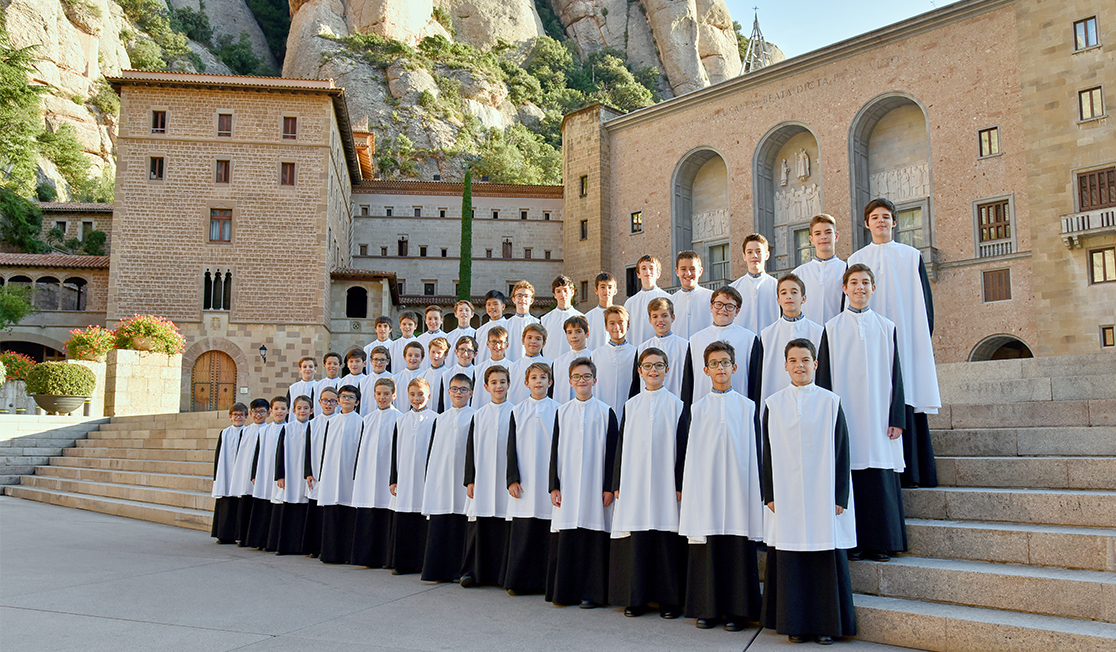Your Digital Program
Info
Program
Escolania sings to the virgin
Germinans germinabit
Gregorian chant
Llibre Vermell
Inperayritz
Codex XIV century
Anselm Viola (1738 – 1798)
Magnificat
Àngel Rodamilans (1874-1936)
Moreneta en sou
Bernat Vivancos (b.1973)
Two liturgical pieces to the Virgin:
Ave Maria (from Ave Maria by Franz Schubert)
Salve Regina
Catalan folksongs and composers
Francesc Civil (1895-1990)
La gata i el belitre (The cat and the scoundrel)
Bernat Vivancos (b.1973)
L’ametller (The almond tree)
Josep Ma. Ruera (1900 - 1988)
La nostra dansa (Our dance)
Bernat Vivancos (b.1973)
El cant dels ocells (The song of the birds)
Albert Guinovart (b. 1962)
Three pieces from El Bestiolari:
Aranya de sostre (Common spider)
Rossinyol viatger (Travelling nightingale)
Ull de bou de festa major (The chiffchaff of the festival)
Program Note
The program we offer you is a very limited sample of the vast liturgical repertoire of the Montserrat musical school over the centuries. In this case, musical pieces dedicated to the Virgin Mary, patroness of our sanctuary, to whom Escolania sings every day.
Catalan culture, specific to the territory called Catalonia, has also generated a traditional repertoire that different Catalan composers have harmonised within different musical aesthetics. You will be able to listen to a small sample of these together with other original works created by Catalan composers.
We wish that this small taste of our musical culture, through our voices, reaches your heart and your homes as a message of beauty and peace.
Germinans germinabit
A Gregorian chant, Introit of the Solemnity Mass to Our Lady of Montserrat, that the Escolania used to sing every morning around the main altar of the church.
Imperayritz
Llibre Vermell
Written in the 14th century, the Montserrat Codex contains different sections (religious and astronomical, for example) and a songbook of ten medieval songs and dances dedicated to the Virgin Mary, the result of the pilgrims' devotion to the Virgin. It is a polyphonic motet, adapted to three voices, in which the figure of the Virgin Mary is praised.
Magnificat
Anselm Viola (1738 – 1798)
Anselm Viola is considered one of the most prestigious musicians of the Montserrat music school. He devoted himself to his life’s work, which was teaching music to the choristers. His musical task was not limited to teaching, however, as he found time to compose musical works to cater for the religious requirements of the monastery.
The vocal and instrumental works of Viola that have been preserved reveal a mature and prolific composer, up-to-date with the modern techniques and forms of his time. His style is characterised by highlighting especially graphic parts of the text with a correspondingly expressive musical setting, as well as by unexpected modulations.
Moreneta en sou
Àngel Rodamilans (1874-1936)
Father Rodamilans is, without doubt, a special, rare and unique composer with a strong and charismatic personality and whose works have a characteristic mark that never leaves someone the same.
The works from his dense and daring final period (with Moreneta en sou, for example), takes inspiration from the works of the first era, yet demonstrate a constant interest in evolving to a more complex and innovative style.
We shall never forget the compositional bravery of Rodamilans, who didn’t want to follow certain norms or rules put in place by the era, but instead valued his own freedom of imagination and expression.
Ave Maria
Bernat Vivancos (b.1973)
"I arranged it [Schubert's Ave Maria] for my wedding… I found it ready-made!" said Bernat Vivancos with a grin, proof of his fascination for, and natural acceptance of, the mysteries of creativity.
To open one’s eyes and let oneself be caressed by Ave Maria is to discover the effect of harmony in the minor key which, after the surprise of the initial disruption of expectations, becomes delectable in the unexpected expressive quality of the melody.
Salve Regina
Bernat Vivancos (b.1973)
The Salve Regina is the prayer that the Escolania sings to the Virgin Mary every day at 1pm. This text has been set to music by many composers of very different styles and eras. The one we present to you comes from a contemporary aesthetic, which employs canatabile fragments, delicacy fragments and ferocious organ interludes. The composer, of international recognition, was a student at the Escolania and was also the director of the choir between 2007 and 2014.
La gata i el belitre
Francesc Civil (1895-1990)
A Catalan folk song of a humorous nature that narrates the vicissitudes in the relationship between a cat and a dog. It is harmonised by Francesc Civil, a former chorister of Montserrat. He goes beyond the simple adaptation and harmonisation to finally become a new creation, developing the themes, making variations and adding new melodies.
L'ametller
Bernat Vivancos (b.1973)
Inspired by a poem by Catalan writer Joan Margall's poem, Bernat Vivancos' L'ametller ("The Almond Tree"), presents us with a landscape where the arpeggiated resonances of the piano surround a serene, three-voiced melody. The piece creates a painting of very personal tones.
La nostra dansa
Josep Ma. Ruera (1900 - 1988)
This is an example of the sardana, a typical Catalan dance. This choir sardana has a fresh, bright and playful character with a high musical quality, reflecting the importance that Ruera gave to the sardana and the need to spread it at all levels.
El cant dels ocells
Bernat Vivancos (b.1973)
A Catalan folk song, popularised by Pau Casals,this work narrates the announcement of the birth of the Infant Jesus through the refined song of the birds in the sky. The harmonisation adopts a neutral and modal language without ever disfiguring the main melody, always present, enveloped by an aura of sound that aims to be constant and uniform.
Three songs from El Bestiolari
Albert Guinovart (b.1962)
These are three playful poems dedicated to three creatures: the common spider, the nightingale and the common chiffchaff. Music, always at the service of the word, plays, laughs and gets excited, giving rise to three small musical gifts.
Llorenç Castelló
Conductor
Born in Barcelona in 1976, he began his music studies at the Escolania de Montserrat, where he studied under Fr. Ireneu Segarra from 1986 to 1990. He obtained the title of Senior Professor of Music theory and Professional in Composition and Piano from the Centre for Higher Education at the Liceu Conservatory. He is a professor at the Music Education Department at the Autonomous University of Barcelona. He was a founding member of the Capella de Música de Montserrat, the men’s choir that occasionally accompanies the Escolania. In 2009, he became Assistant Director of the Escolania de Montserrat and, in 2012, was appointed Director of the Capella de Música as well. In 2014, he took over as Director for the Escolania de Montserrat, where he carries on with the music tradition he received as a child, cherishing the centuries-long music tradition of Montserrat while also pursuing more modern music projects.
Mercè Sanchis
Accompanist/Organist
Born in Esparreguera, Mercè holds degrees in piano, organ, and chamber music from the Barcelona Superior Conservatory of Music. In the class of 1998-99, she graduated with top marks for her organ studies. Mercè has studied with M. Schroeder, M.Radulescu, Daniel Roth, Montserrat Torrent and R. Fresco. She has collaborated with the Orquestra de Cambra de l’Empordà, the Camerata Cibiniensis (Romania), ONCA, Camerata XXI, Orquestra Simfònica del Vallès, Orquestra Simfònica de Barcelona i Nacional de Catalunya and the Orquesta Sinfónica de Navarra, and with choirs such as Orfeó Català, Cor de Cambra del Palau de la Música Catalana, Cor del Gran Teatre del Liceu, Cor Madrigal and Orfeón Donostiarra, and has had the opportunity to work closely with the most prestigious directors, both from within the country and from the international sphere: S. Brotons, S. Mas, A. Ros Marbà, E. Martínez Izquierdo, Jesús L. Cobos, Pierre Cao, F.P. Decker, R. King, Eiji Owe, Zubin Mehta, R.Alessandrini, and M. Rostropovich. Since September 1999 she has been the pianist and organist of Orfeó Català, and since 2009 the organist of the Escolania de Montserrat.
About Escolania de Montserrat
Escolania de Montserrat is amongst the oldest music schools in Europe. As early as the 13th century, a small group of young men emerged who, through the practice of singing and playing various musical instruments, were at the service of this unique place. Throughout the centuries, it has contributed to the formation of many young men, some of whom have become remarkable composers and performers of the renowned Escola Musical Montserratina. In more recent years, it has recorded its own repertoire, and for the last 50 years has been singing outside the monastery, performing in numerous concerts around Catalonia and participating in festivals in countries including the United States, China, Italy, Germany, Russia, Hungary, Switzerland, Belgium, France and Poland.
At present, the Escolania is made up of about fifty boys, from nine to fourteen years old, who throughout four or five years carry out the general studies depending on their age, combined with a very personalised musical education. The purpose of the Escolania, both now and in the past centuries, is the daily participation in the prayer of the sanctuary, which receives a great influx of visitors from all over the world, but also the dissemination of the music of the Escola Montserratina, and occasionally folk and/or songwriter music, as the present recording exhibits.






A Festival for the Future
Adelaide Festival is proudly Carbon Neutral and you can help us reduce our impact on the environment further! This year, Adelaide Festival has partnered with Reforest and Trees for Life to support the Mannavale farm bushfire recovery project in Adelaide Hills.
Plant one for the planet as part of your Adelaide Festival experience. You can learn more about the project, take action and track your impact here.
Your contribution through Reforest will help repair the damage caused by both bushfires and historical land clearing, and help Trees for Life plant a range of native species to restore an area of forest habitat for native wildlife.



